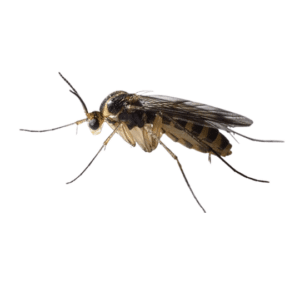
Fungus Gnat

Anatomy, Feeding, and Living Spaces
Fungus gnats, tiny insects often overlooked, become noticeable nuisances in homes and gardens. Belonging to the Sciaridae family, these small flies thrive in moist environments where fungi flourish. Let’s explore the world of fungus gnats, focusing on their habitats, life cycles, and impacts on our surroundings.
These insects love wet, organic-rich areas. You’ll often find them in overwatered houseplants, gardens, and compost piles. They’re attracted to the fungi in these moist conditions, making them frequent visitors in greenhouses and homes with indoor plants.
Larvae of fungus gnats primarily feed on fungi and organic matter in the soil. In contrast, adult gnats usually fly around plants or near windows rather than feeding significantly.
These gnats are small, with lengths ranging from 2 to 5 mm. They have slender bodies, long legs, and distinct, clear wings. Their small size and dark coloration often make them hard to notice until they appear in large numbers.
The Speedy Growth of Fungus Gnats
Fungus gnats reproduce rapidly. Females lay eggs in moist soil or decaying organic matter, where larvae feed on fungi and decaying plants. This cycle, from egg to adult, happens swiftly, often within a few weeks.
The life cycle of a goes through egg, larva, pupa, and adult stages. This process can take as little as three to four weeks, depending on the conditions, leading to quick population growth.
Harmful to Plants, Harmless to Humans
Fungus gnats don’t usually cause major environmental damage, but they can harm seedlings and young plants. Their larvae feed on roots, potentially stunting plant growth and causing death in severe cases.
For humans, they can pose minimal health risks. They don’t bite or transmit diseases, but their presence can be annoying, especially in large numbers.
Their Invasive Tendencies in Domestic Spaces
In the right conditions, fungus gnats can become invasive. They’re not aggressive or harmful to humans, but their fast reproduction can cause large infestations in homes and greenhouses.
Fungus gnats often invade homes via infested houseplants or potting soil. High humidity and decaying organic matter also attract them.
Commonly, you’ll find fungus gnats around houseplants, in kitchens, and bathrooms. Regularly inspecting plants, watering properly, and keeping environments dry are crucial to preventing infestations.
Conclusion
It’s crucial to understand fungus gnat behavior and life cycles for effective management and prevention. Maintaining healthy indoor plants, avoiding overwatering, and reducing moisture are key strategies. Although fungus gnats are common in homes with houseplants, regular care and attention can manage them effectively. Stay tuned to our blog for more pest control tips and information.

